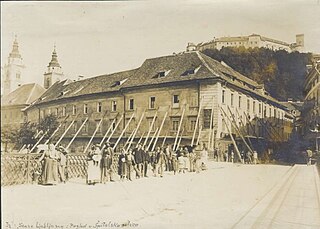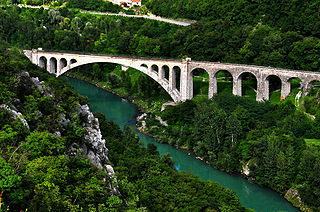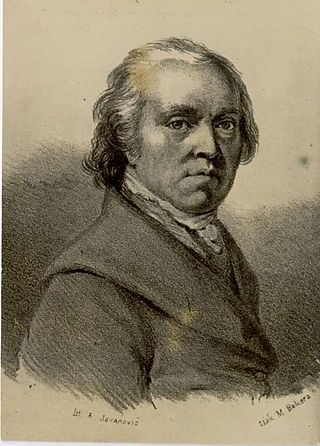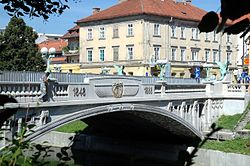
Ljubljana is the capital and largest city of Slovenia, located along a trade route between the northern Adriatic Sea and the Danube region, north of the country's largest marsh, inhabited since prehistoric times. It is the country's cultural, educational, economic, political and administrative center.

Jože Plečnik was a Slovene architect who had a major impact on the modern architecture of Vienna, Prague and of Ljubljana, the capital of Slovenia, most notably by designing the iconic Triple Bridge and the Slovene National and University Library building, as well as the embankments along the Ljubljanica River, the Ljubljana Central Market buildings, the Ljubljana cemetery, parks, plazas etc. His architectural imprint on Ljubljana has been compared to the impact Antoni Gaudí had on Barcelona.

The Triple Bridge comprises three bridges spanning the Ljubljanica River in Ljubljana, the capital of Slovenia. It connects the historical medieval town on the southeastern bank with the central Prešeren Square on the northwestern bank. Dating back to the 13th century, it stands as the oldest bridge in Ljubljana. In the early 1930s, the architect Jože Plečnik redesigned and expanded it. In August 2021, the Triple Bridge was added to the UNESCO World Heritage List as part of Plečnik's enduring legacy.

Anton Dominik Ritter von Fernkorn was a German-Austrian sculptor.

Oton Župančič was a Slovene poet, translator, and playwright. He is regarded, alongside Ivan Cankar, Dragotin Kette and Josip Murn, as the beginner of modernism in Slovene literature. In the period following World War I, Župančič was frequently regarded as the greatest Slovenian poet after Prešeren, but in the last forty years his influence has been declining and his poetry has lost much of its initial appeal.

Ivan Vurnik was a Slovene architect that helped found the Ljubljana School of Architecture. His early style in the 1920s is associated with the search for Slovene "National Style", inspired by Slovene folk art and the Vienna Secession style of architecture. Upon embracing the functionalist approach in the 1930s, Vurnik rivaled the more conservative Plečnik's approach. The Cooperative Business Bank, designed by Vurnik and his wife Helena Kottler Vurnik who designed the decorative facade in the colors of Slovene tricolor, has been called the most beautiful building in Ljubljana. Vurnik has also drawn a number of urban plans, among these the plans for Bled (1930), Kranj (1933–1937), and Ljubljana (1935).

An earthquake struck Ljubljana, the capital and largest city of Carniola, a crown land of Austria-Hungary and the capital of modern-day Slovenia, on Easter Sunday, 14 April 1895. It was the most, and the last, destructive earthquake in the area.

The Solkan Bridge is a 219.7-meter (721 ft) arch bridge over the Soča River near Nova Gorica in western Slovenia. With an arch span of 85 meters (279 ft), it is the world's longest stone arch railroad bridge. It holds this record because later construction technology used reinforced concrete to build bridges. It was originally built to carry the Bohinj Railway in the time of the Vienna Secession, between 1900 and 1905, and officially opened in 1906.

The Butchers' Bridge is a footbridge crossing the river Ljubljanica in Ljubljana, the capital of Slovenia. It connects the Ljubljana Central Market and the Petkovšek Embankment. The bridge was solemnly opened on 10 July 2010.

The Prule Bridge or the Brickmakers' Bridge is a bridge crossing the Ljubljanica River in Ljubljana, the capital of Slovenia. It is located in the Trnovo District to the south of the Ljubljana old town and links the residential districts of Prule and Trnovo. It is shaped like a wide platform on two columns with lookout balconies and with wide pavements, covered with red brick.

St. Peter's Bridge, also Ambrož Bridge, is a bridge in Ljubljana, the capital of Slovenia, that crosses the river Ljubljanica in the northeastern end of the old town. It is a continuation of Rozman Street. West of it lie Vraz Square on the northern (left) bank of the river and Ambrož Square on its southern (right) bank. East of it lies the Petkovšek Embankment on the northern bank and the Poljane Embankment on the southern bank. The bridge is named after the nearby St. Peter's Church. It is intended primarily for motorised traffic, but is also used by pedestrians.

St. James's Bridge in Ljubljana is a bridge that crosses the Ljubljanica River on the southern end of downtown Ljubljana, next to Zois Manor. It links Zois Street and Karlovac Street. The most important city traffic artery across the Ljubljanica runs across it.

Josef Melan (1854–1941) was an Austrian engineer. He is regarded as one of the most important pioneers of reinforced concrete bridge-building at the end of the 19th century. Josef Melan is credited as the inventor of the Melan System, a method for the construction of reinforced bridges. The Melan System differed from previous reinforced bridges because Melan did not build iron bars into the reinforced concrete bridge structure, but used rigid truss arches made of iron. Melan became famous in 1898 after building a 42.4 m bridge with a very shallow arch in Steyr. At that time, this was the largest reinforced concrete bridge in the world. He also built the Dragon Bridge in Ljubljana.

Raka is a village in the Municipality of Krško in eastern Slovenia. The area is part of the traditional region of Lower Carniola. It is now included with the rest of the municipality in the Lower Sava Statistical Region. The village is known for a quality variety of onion.

The Grain Bridge is a footbridge over the Ljubljanica River in Ljubljana, the capital of Slovenia. It is located between Tanner Street and Gestrin Street, and links the Petkovšek Embankment on the left side of the river and the Poljane Embankment on its right side. It is used by local residents and students of the Poljane Grammar School and has relieved of pedestrians the St. Peter's Bridge and the Dragon Bridge.
The Ljubljana Central Market is a market in Ljubljana, Slovenia. The riverside market building, sometimes referred to as Plečnik's Market, was designed by Jože Plečnik between 1931 and 1939. It stretches between the Triple Bridge and the Dragon Bridge, on the right bank of the Ljubljanica River. The marketplace and Vodnik Square, where it is located, are cultural monuments of national significance. It is partly located at Adamič and Lunder Embankment and at Pogačar Square.

Franz Caucig, Franco Caucig or Francesco Caucig, also known in Slovene as Franc Kavčič or Frančišek Caucig was a Neoclassical painter and drawer of Slovene origin. He is one of the best representatives of the Central European Neoclassicism. He attained the highest positions and recognitions of all the artists of Slovene descent.

Parliamentary elections were held in Slovenia on 4 December 2011 to elect the 90 deputies of the National Assembly. This was the first early election in Slovenia's history. The election was surprisingly won by the center-left Positive Slovenia party, led by Zoran Janković. However, he failed to be elected as the new Prime Minister in the National Assembly, and the new government was instead formed by a right-leaning coalition of five parties, led by Janez Janša, the president of the second-placed Slovenian Democratic Party. The voter turnout was 65.60%.

The Prešeren Monument in Ljubljana, also Prešeren Statue in Ljubljana, is a late Historicist bronze statue of the Slovene national poet France Prešeren in Ljubljana, the capital of Slovenia. It stands in the eastern side of Prešeren Square, in front of the Central Pharmacy Building in Ljubljana, the capital of Slovenia. It is among the best-known Slovenian monuments.
The Ljubljana LGBT Film Festival is an annual international LGBT film festival held in Ljubljana, Slovenia. It is the oldest film festival of its sort in Europe and also the oldest international film festival in Slovenia. It showcases LGBT-themed films, i.e. films with nonheterosexual and non-cisgender topics or motifs.






















